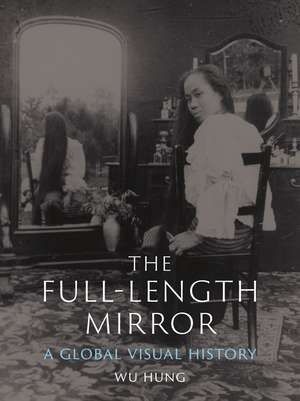The Full-Length Mirror: A Global Visual History
Autor Wu Hungen Limba Engleză Hardback – 12 ian 2023
This book tells two stories about the full-length mirror. One story, through time and space, crisscrosses the globe to introduce a broad range of historical actors: kings and slaves, artists and writers, merchants and craftsmen, courtesans, and commoners. The other story explores the connections among objects, painting, and photography, the full-length mirror providing a new perspective on historical artifacts and their images in art and visual culture. The Full-Length Mirror represents a new kind of global art history in which “global” is understood in terms of both geography and visual medium, a history encompassing Europe, Asia, and North America, and spanning over two millennia from the fourth century BCE to the early twentieth century.
Preț: 227.52 lei
Preț vechi: 242.03 lei
-6% Nou
Puncte Express: 341
Preț estimativ în valută:
43.54€ • 45.37$ • 36.05£
43.54€ • 45.37$ • 36.05£
Carte disponibilă
Livrare economică 13-20 martie
Livrare express 26 februarie-04 martie pentru 61.81 lei
Preluare comenzi: 021 569.72.76
Specificații
ISBN-13: 9781789146103
ISBN-10: 1789146100
Pagini: 288
Ilustrații: 70 color plates, 90 halftones
Dimensiuni: 159 x 210 x 25 mm
Greutate: 0.73 kg
Editura: REAKTION BOOKS
Colecția Reaktion Books
ISBN-10: 1789146100
Pagini: 288
Ilustrații: 70 color plates, 90 halftones
Dimensiuni: 159 x 210 x 25 mm
Greutate: 0.73 kg
Editura: REAKTION BOOKS
Colecția Reaktion Books
Notă biografică
Wu Hung is the Harrie A. Vanderstappen Distinguished Service Professor of Art History at the University of Chicago. His many books include A Story of Ruins: Presence and Absence in Chinese Art and Visual Culture and Zooming In: Histories of Photography in China, both also published by Reaktion Books.
Recenzii
"Hung recounts how reflective glass did more than cater to vanity over the millenniums. An ancient Chinese ruler known as the Muddle-Headed Marquis was buried with a bronze mirror trimmed in paintings of fierce beasts, which he was convinced would bring prosperity and 'dispel evil and inauspiciousness.' Mirrors enabled wealthy ancient Romans to observe their bodily functions in bathrooms and bedrooms. Louis XIV’s henchmen used industrial espionage to steal Venetian mirror-making formulas, which called for toxic layers of mercury. And American abolitionist photographers posed formerly enslaved people alongside mirrors. The simultaneous face and profile views made for emotionally powerful photos, which were sold for the benefit of schools for Black children. As the book suggests, there was anxiety over reflections, too, which long predated vampire novels and starlets; an emperor in seventh-century China once ripped out his mirrors after a government minister warned that the ruler’s images 'scattered everywhere' in the halls of power posed a risk of offending the gods."
"While the ancient Greeks, Romans, and Chinese attempted to build large reflective devices, the first full-length mirrors as we know them date back to seventeenth-century Europe. Hung’s illustrated history shows how large mirrors crisscrossed the globe and gave viewers new perspectives on their visual environments. Regarded by the Greco-Romans as possessing supernatural powers, large mirrors later came to be viewed as a means of discovering the self. The book begins with a detailed history of these 'alluring objects,' as Hung calls them, before shifting to an investigation of full-length mirror portraiture, a popular nineteenth-century artistic form, and the use of mirrors in the work of Indian filmmaker Satyajit Ray."
“As has been the case with the numerous other books Wu Hung has offered us, The Full-Length Mirror is a significant work that aptly displays his original ideas, lucid writing and unparalleled erudition: no full-length mirror will ever be large enough to reflect the towering presence and shadow he has marked on art history and Sinology.”
“In an impressive sweep across time and space, enlivened by penetrating insights, this very readable study uses the full-length mirror as a point of entry into a highly stimulating range of questions about technologies, representations, and the connections between them.”
“In this highly original and enthralling study, Hung takes readers on a journey across time, space, and media to explore how emperors as well as ordinary individuals in both China and Europe used full-length mirrors to express power, desire, memory and the self. The images are as stunning as the insights.”
